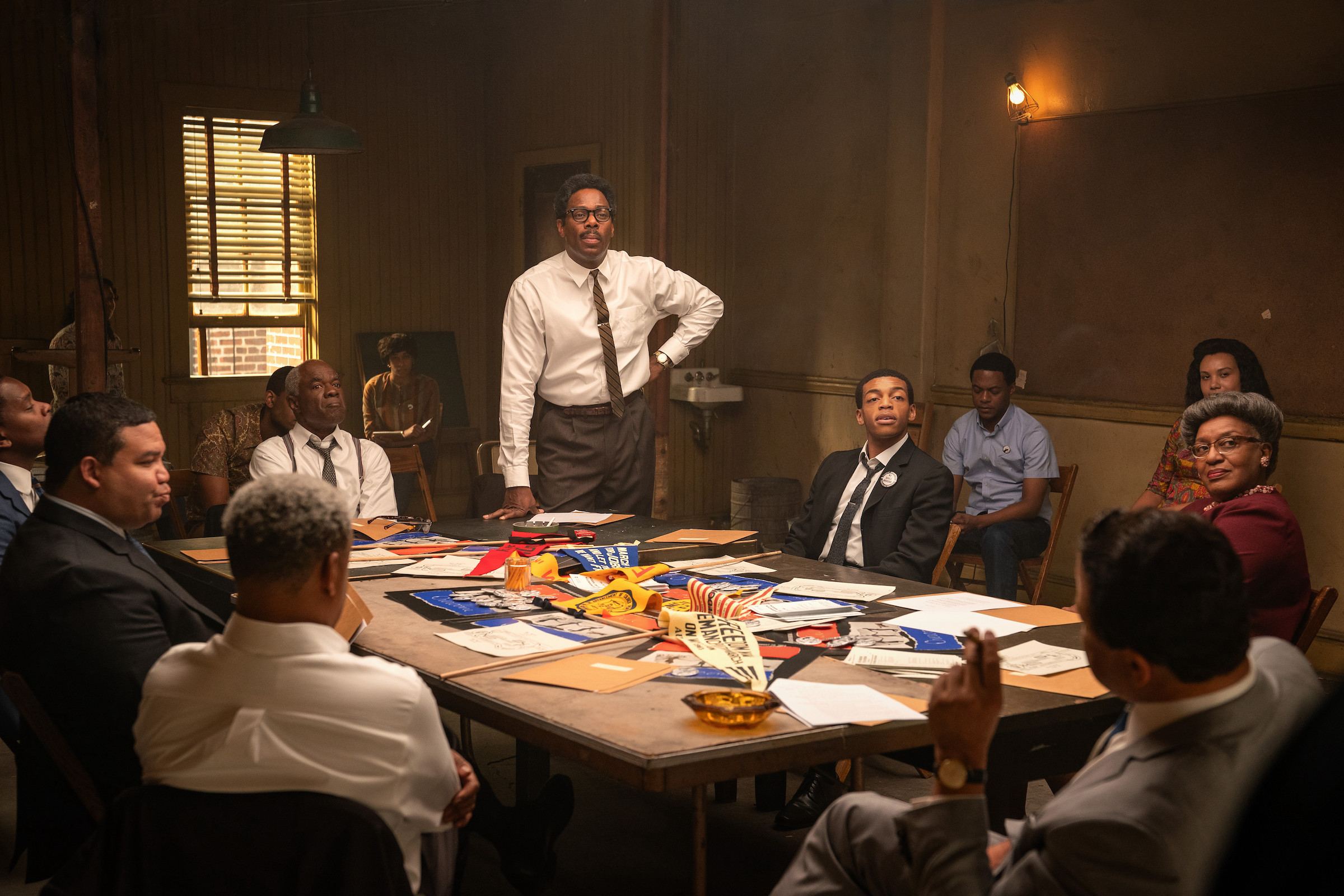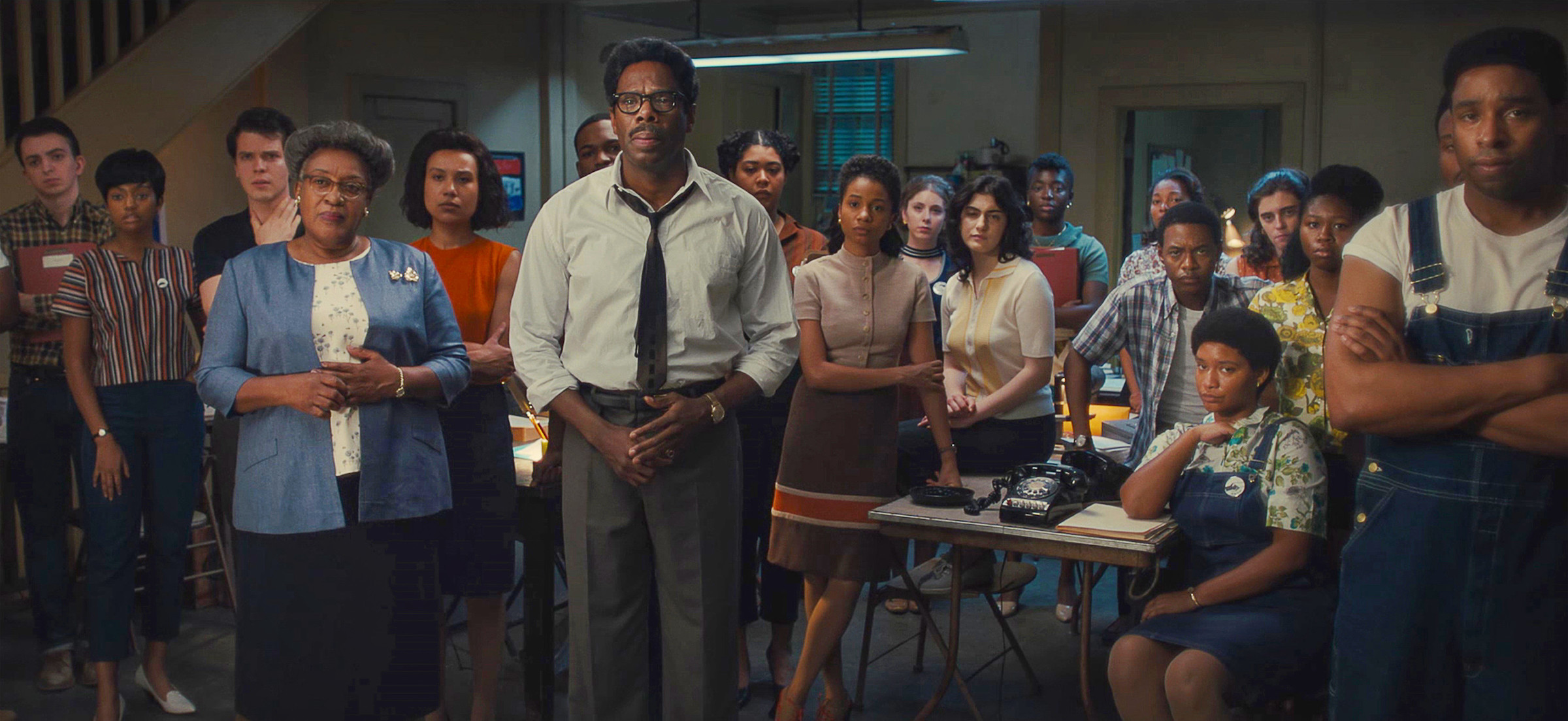
In a pivotal scene in Rustin, a biopic coming to Netflix on Nov. 17, organizer Bayard Rustin (Colman Domingo) stares down his antagonist, Congressman Rev. Adam Clayton Powell Jr. (Jeffrey Wright). The film has been building to this moment: throughout, Powell has taken several vile jabs at Rustin about his sexuality. And he is now, through a sly hypothetical question, insinuating that Rustin, a gay man, should resign his post as deputy director of the 1963 March on Washington, lest he derail the movement for racial justice. The camera slowly pans around the room, lingering on the disapproving facial expressions of the civil rights organizers—young and older, Black and white, women and men—who are also gathered at this key strategy meeting.
“Hypothetically speaking,” a poised Rustin says in response to Powell’s query, “I’d send them on their way. Unless, the person in question happened to be me.” Several people burst into laughter. Rustin, then empowers his team of teenaged and young adult organizers to regale the senior civil rights leaders with news of what they have accomplished—working fifteen hours a day—in the mere seven weeks that they’ve been diligently toiling to plan what will be the largest demonstration in civil rights history. They roll off an impressive list: securing 2220 chartered buses, 40 trains, and 6 planes to bring marchers to the nation’s capital; 80,000 boxed lunches, 292 toilets, and 22 first aid stations. It is then that viewers begin to comprehend the herculean task of executing a large-scale civil rights demonstration. Rustin’s genius is on full display.
Read More: The History Behind Rustin
Bayard Rustin is beyond deserving of a biopic. From his Quaker youth, Rustin devoted his life to the movement for Black Freedom. By adulthood, he had matured into a brilliant intellectual, skilled debater, and grassroots organizer. Rustin’s teachings about radical pacifism and the power of direct nonviolent action influenced Dr. Martin Luther King’s own politics. Yet Rustin remained in the shadows of the movement as King and others rose to national prominence. Certainly, his identity as an out (by 1960s standards) gay, Black man in a movement with strong religious overtones was a factor. As were his ties to the Communist Party in the 1930s. LGBTQ activists and historians have worked since Rustin’s death, in 1987, to center his legacy in U.S. civil rights history. And finally, Barack and Michelle Obama’s Higher Ground production company has brought Rustin’s story to life in a feature-length film.
“[Rustin] is a role model for what it means to be an American,” director George C. Wolfe says in the film’s press notes. “What it means to daily, moment-to-moment, commit to democracy, commit to freedom, commit to possibility.” Wolfe knows the biopic genre well, having directed the critically acclaimed Ma Rainey’s Black Bottom (2020) and The Immortal Life of Henrietta Lacks (2017). With Rustin, he knew he needed to show the complexities of Rustin, his “sense of service, expansive curiosity, and caring for those in need” as well as “the organizational brain of this man.”

The challenge for Rustin filmmakers would be creating a new visual lexicon for a civil rights era film. Viewers are accustomed to movement films such as Mississippi Burning (1988) that show the horrors of anti-Black violence across the South, Malcolm X (1992), with its extended scenes of Malcolm’s soaring oratory, and Selma (2014), which visually depicted the scope and scale of marches and freedom rides. Yet, Bayard Rustin’s organizational work, by the 1960s, was largely conducted in meeting rooms and offices. And the film is set in New York City, not the more common Deep South. How could they visually convey the intellectualism, influence, and reach of a movement organizer who was not on the front lines, in a style that would feel familiar and engaging for audiences encountering Rustin for the first time?
Centering the film in the two months leading up to the March on Washington helps give it a sense of urgency. The film’s hard bop jazz score anchors it temporally and serves as a sonic representation of Rustin’s cerebral nature. Rustin’s immensely talented (and in many ways underutilized) supporting cast—including Chris Rock, Audra McDonald, Glenn Turman, and CCH Pounder—help convey the fractured political state of the movement in 1963. Still these elements alone would not be enough to help viewers reimagine the civil rights genre.
Wolfe creates what can be described as a “two room” visual strategy that allows him to depict the genius and impact of Rustin’s vision for democratic worldbuilding—and how it stood in contrast to the work of other civil rights leaders. Room One: the conference room of the NAACP headquarters. Scenes filmed here are dark and drab. A large conference table, at which NAACP leader Roy Wilkins (played by Chris Rock) sits at the head, is positioned at the center of the room, making a literal distinction between those (men) who have a seat at the table and those (women and openly queer folks) who do not. Mahogany wood paneled walls and dim lighting evoke the staid politics of these old guard leaders. The men seated around the table are dressed in dark or neutral-toned suits, their voices even and serious. Rustin eventually shouts out, disrupting the status quo of the meeting. He is seated in the corner of the room, next to the female secretaries. Wilkins, having no interest in those seated at the margins, had no clue Rustin was even in the room—or was at least willing to ignore him unless Rustin made his presence known. Wolfe opts for a long camera angle shot to create even greater spatial distance between the two men, which symbolizes the gulf between their politics.
Read More: Civil Rights Activists in Netflix’s Rustin Recall Planning the March on Washington
Room Two: Rustin’s March on Washington headquarters, at the Utopia Neighborhood Club House, in Harlem, is abuzz with energy. It stands in stark contrast to the NAACP headquarters. The color palette of the room is a vibrant yellow. There is no conference table in the middle of the room, in fact, most people are working on their feet, bustling about the space as they make phone calls and check off their to-do lists. In this configuration, there is no defined center and margins, there is no hierarchy. The interracial staff of organizers, who Rustin refers to as “angelic troublemakers” are dressed more casually and on trend with the styles of the day. Some folks are gay, some present as gender nonbinary. They are the more progressive members of organizations such as the NAACP, SNCC, CORE, and SCLC. “Talk. Shout. Take command!” Rustin says to the group of budding organizers during a key planning meeting. He encourages them to be effective disrupters. This room is the world Bayard Rustin has made.

Rustin does not offer any altogether new revelations about the significance of the March on Washington. In fact, it reifies the widely accepted narrative of the march as a triumphant moment for the movement and a transformative moment in US history. It does not zoom out beyond the groups assembled in its two rooms to show the degree to which the march was hotly contested by the more radical, grassroots arm of the movement. For example, Malcolm X referred to the march as the “Farce on Washington.” He was critical of the White House’s heavy involvement in the planning of the march and the big dollar donations that “Big Six” civil rights leaders such as Wilkins, King, and Whitney Young received from philanthropic foundations to underwrite it.
But the film is triumphant in that it proves that centering the most marginalized, like Bayard Rustin, brings other underappreciated, undercelebrated activists into the national conversation. In the film’s closing scene, Bayard Rustin is collecting trash from the National Mall lawn. King has given his now classic “I have a Dream” speech, to rousing applause. Wilkins and the Big Six have brokered an Oval Office meeting with President Kennedy to make him commit to civil rights legislation. And yet Rustin—somewhat by his own choice—does not enter that room. As this scene conveys, his work is, literally, at the grassroots. Thus, by focusing on grassroots organizers, Rustin pays tribute to people such as Anna Arnold Hedgeman, Ella Baker, Joyce and Dorie Ladner, Eleanor Holmes Norton, Cortland Cox, Rachelle Horowitz—many of whom are still alive to receive their flowers.
Tanisha C. Ford is a history professor at the Graduate Center, CUNY. She is also the author of several books, including Our Secret Society: Mollie Moon and the Glamour, Money, and Power Behind the Civil Rights Movement.
More Must-Reads From TIME
- The 100 Most Influential People of 2024
- Coco Gauff Is Playing for Herself Now
- Scenes From Pro-Palestinian Encampments Across U.S. Universities
- 6 Compliments That Land Every Time
- If You're Dating Right Now , You're Brave: Column
- The AI That Could Heal a Divided Internet
- Fallout Is a Brilliant Model for the Future of Video Game Adaptations
- Want Weekly Recs on What to Watch, Read, and More? Sign Up for Worth Your Time
Contact us at letters@time.com